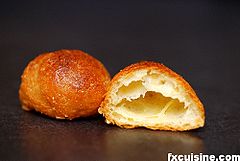
Gougère
Encyclopedia

French cuisine
French cuisine is a style of food preparation originating from France that has developed from centuries of social change. In the Middle Ages, Guillaume Tirel , a court chef, authored Le Viandier, one of the earliest recipe collections of Medieval France...
, is a baked savory choux pastry
Choux pastry
Choux pastry, or pâte à choux , is a light pastry dough used to make profiteroles, croquembouches, éclairs, French crullers, beignets, St. Honoré cake, Indonesian kue sus, and gougères. It contains only butter, water, flour, and eggs...
made of choux dough mixed with cheese. There are many variants. The cheese is commonly grated Gruyère
Gruyère (cheese)
Gruyère is a hard yellow cheese, named after the town of Gruyères in Switzerland, and originated in the cantons of Fribourg, Vaud, Neuchâtel, Jura, and Berne...
, Comté
Comté (cheese)
Comté is a French cheese made from unpasteurized cow's milk in the Franche-Comté region of eastern France.Comté has the highest production figures of all French AOC cheeses, making around 40,000 tonnes annually...
, or Emmentaler
Emmental (cheese)
Emmental or Emmentaler is a cheese from Switzerland. It is sometimes known as Swiss cheese in North America, Australia and New Zealand, although Swiss cheese does not always imply Emmentaler....
, but there are many variants using other cheeses or other ingredients.

Sens
Sens is a commune in the Yonne department in Burgundy in north-central France.Sens is a sub-prefecture of the department. It is crossed by the Yonne and the Vanne, which empties into the Yonne here.-History:...
.
Gougères can be made as small pastries, 3-4 cm. in diameter; aperitif gougères; 10-12 cm.; individual gougères; or in a ring. Sometimes they are filled with ingredients such as mushroom
Mushroom
A mushroom is the fleshy, spore-bearing fruiting body of a fungus, typically produced above ground on soil or on its food source. The standard for the name "mushroom" is the cultivated white button mushroom, Agaricus bisporus; hence the word "mushroom" is most often applied to those fungi that...
s, beef, or ham; in this case the gougère is usually made using a ring or pie tin.
In Burgundy, they are generally served cold when tasting wine in cellars, but are also served warm as an appetizer.
History
In the eighteenth and nineteenth-century, gougère were sometimes made of choux pastry, but sometimes apparently just of cheese, eggs, and breadcrumbs. The presentation was usually a flat circle, neither a sphere nor a ring.Earlier forms of gougère were more a stew than a pastry, including herbs, bacon, eggs, cheese, spices, and meat mixed with an animal's blood, and prepared in a sheep's stomach. In medieval France, it was a kind of cheese tart or pie. Later, it was unknown outside what is now Belgium, where it became associated with Palm Sunday
Palm Sunday
Palm Sunday is a Christian moveable feast that falls on the Sunday before Easter. The feast commemorates Jesus' triumphal entry into Jerusalem, an event mentioned in all four Canonical Gospels. ....
. But it was also attested in Auxerre
Auxerre
Auxerre is a commune in the Bourgogne region in north-central France, between Paris and Dijon. It is the capital of the Yonne department.Auxerre's population today is about 45,000...
(Burgundy) in the 19th century under the name gouere.
Name
The word gougère was formerly spelled gouiere, gouyere, goïère, goyère, or gouyère. The modern spelling appears to date from the 18th century.The ultimate origin of the word is unknown.

